Page 019 from

Start-Up Activity
Ask students, "What do you look for in a friend?" They will probably offer suggestions like, "someone fun," or "someone I can hang out with." Others might say, "a person I can trust" or "a person who gets me and lets me be who I am." As they offer ideas, write on the board adjectives like "fun," "easy-going," "trustworthy," and "accepting." After the conversation, list the opposites of these words "boring," "demanding," "back-stabbing," "judgmental."
Then sum up the two lists, saying something like "We can all pretty much agree that we want friends who are fun, easy-going, trustworthy, and accepting and not friends who are boring, demanding, back-stabbing, and judgmental." Call the first list "the traits of good friends."
Then say that readers use a similar set of traits when they befriend or reject books and other writing. In this chapter, students will have a close look at these traits of effective writing.
Think About It
“Outside of a dog, a book is man's best friend. Inside of a dog it’s too dark to read.”
—Groucho Marx

Start-Up Activity
Ask students, "What do you look for in a friend?" They will probably offer suggestions like, "someone fun," or "someone I can hang out with." Others might say, "a person I can trust" or "a person who gets me and lets me be who I am." As they offer ideas, write on the board adjectives like "fun," "easy-going," "trustworthy," and "accepting." After the conversation, list the opposites of these words "boring," "demanding," "back-stabbing," "judgmental."
Then sum up the two lists, saying something like "We can all pretty much agree that we want friends who are fun, easy-going, trustworthy, and accepting and not friends who are boring, demanding, back-stabbing, and judgmental." Call the first list "the traits of good friends."
Then say that readers use a similar set of traits when they befriend or reject books and other writing. In this chapter, students will have a close look at these traits of effective writing.
Think About It
“Outside of a dog, a book is man's best friend. Inside of a dog it’s too dark to read.”
—Groucho Marx